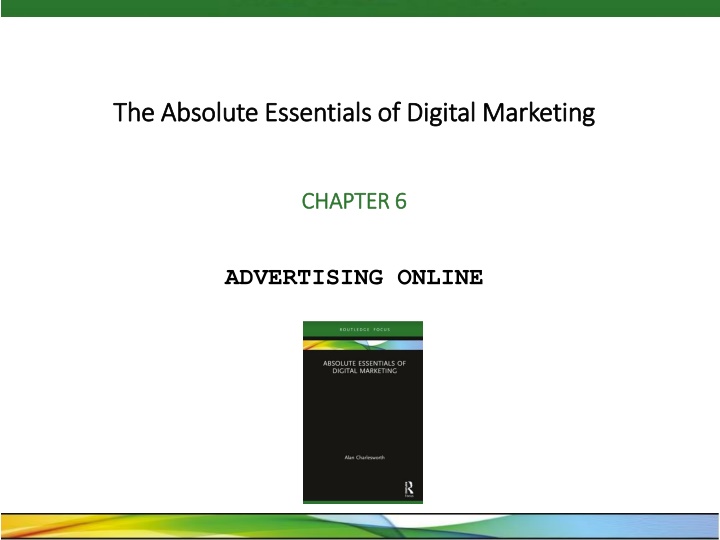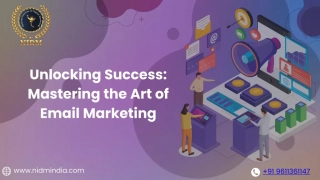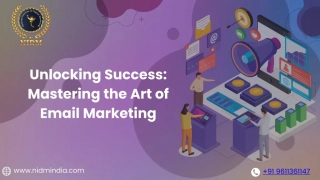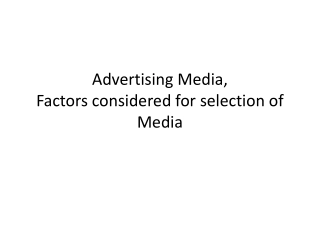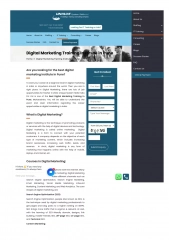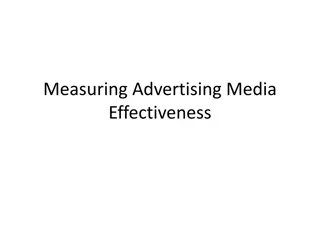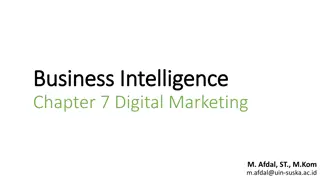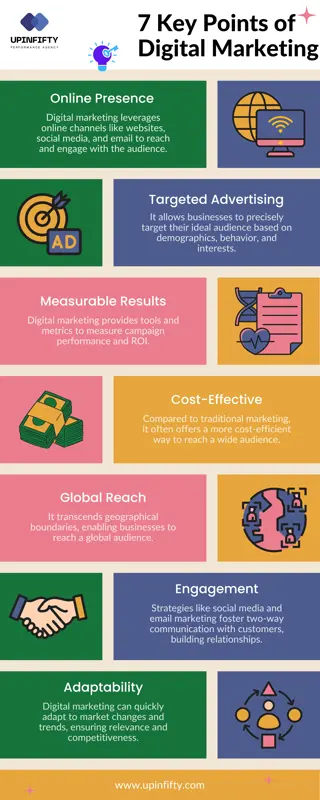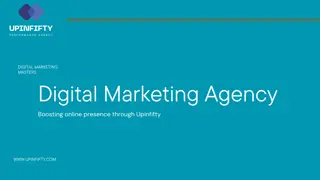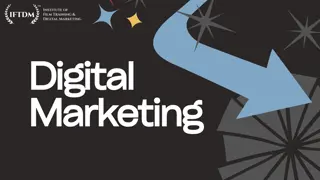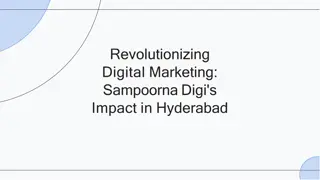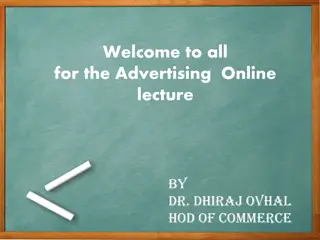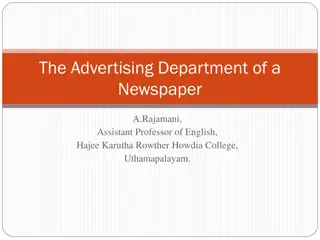The Essentials of Online Advertising in Digital Marketing
Online advertising plays a crucial role in digital marketing, encompassing various types such as network/display, programmatic, retargeting, and more. This chapter delves into the importance of coordinating online advertising campaigns across different platforms, clarifies terms like automated, programmatic, network, and display, and explains methods of ad delivery like keyword bidding, display network ads, direct ads, and native advertising. It also touches on search advertising, keyword bidding strategies, and the significance of keywords in ad campaigns.
Download Presentation

Please find below an Image/Link to download the presentation.
The content on the website is provided AS IS for your information and personal use only. It may not be sold, licensed, or shared on other websites without obtaining consent from the author.If you encounter any issues during the download, it is possible that the publisher has removed the file from their server.
You are allowed to download the files provided on this website for personal or commercial use, subject to the condition that they are used lawfully. All files are the property of their respective owners.
The content on the website is provided AS IS for your information and personal use only. It may not be sold, licensed, or shared on other websites without obtaining consent from the author.
E N D
Presentation Transcript
The Absolute Essentials of Digital Marketing The Absolute Essentials of Digital Marketing CHAPTER 6 CHAPTER 6 ADVERTISING ONLINE
Why Why all all online advertising online advertising is is advertising advertising This matter where it is hosted. chapter considers online advertising no The specific available in an SEO or social media environment. development of set effective which adverts is requires necessarily a skill not There advertising including network/display, programmatic, retargeting and Amazon are several recognised types of online Advertising platforms campaigns should be coordinated across
Automated, programmatic, network or display? Automated, programmatic, network or display? Seemingly used at random when referring to aspects of online advertising it s reasonable to assert that no-one can really clarify these terms. The used misinterpretation of them. problems arise, and mainly, the from the terminology misunderstanding and
Ad delivery Ad delivery Four fundamental methods of delivery to a web page: 1. Keyword bidding: the ad appears on the page in response to keywords associated with the user in one of two ways: Direct (search engine) Indirect: (web page). 2. Display network advertising: banner ads delivered on websites. 3. Direct (contact) ads: advertisers and publishers deal with each other directly. 4. Native advertising: the appearance of these ads is such that they are not obviously an advert.
SEARCH ADVERTISING SEARCH ADVERTISING Important: advertising on SERPs is not the same as being featured in their organic results. SEO SERP advertising, the keywords are purchased by the advertiser (hence it is paid search). seeks to match content with search terms with sometimes referred to as The listings is the one that has made the best bid made for it. ad that appears highest on the SERP s ads The clicks on the ad (the pay-per-click PPC model). fee is payable to the only SE when someone Cost less popular keywords being cheaper the so-called long tail of keywords. is influenced by the level of competition
Keyword bidding Keyword bidding Keywords for ads can be the same as those used for SEO or different depending on whether the objective is to reinforce essential appeal across organic search and advertising. terms or spread keyword In addition to the monetary value of the bid, the strength of each bid is measured against: Clickthrough rate (CTR) history. Landing page quality. Ad Relevance.
Google shopping ads Google shopping ads Shopping immediate sales, there are three types: ads offer the potential of generating 1. Product Shopping ads 2. Showcase Shopping ads 3. Local catalogue ads Similar shopping ads are available on Bing Ads and Yahoo Gemini.
DISPLAY NETWORK ADVERTISING DISPLAY NETWORK ADVERTISING Commonly advertising includes that: abbreviated to display, display network Ads are delivered on websites that are part of the network. Ads can be associated with web page content. Ads can be specific to groups of users based on clickstream data or behavioural actions. or contextual Ads can be personalized to the individual user.
Advertising on social media Advertising on social media social media A advertisers : variety of platforms are available to Facebook advertising not only delivers ads on Facebook pages, but also throughout a wide network of apps and non-website media. the social media platform s network Twitter purchased by auction or automated bidding Pinterest the image based platform uses visual pins rather than textual ads. It also has shopping ads YouTube TrueView roll ads and Bumper ads are non-skippable and appear at the end of videos. three video ads, ad non-skippable categories are Pre-roll available: / skippable Mid- Instagram carousel, story and collection ads. standard photo and video ads plus
PROGRAMMATIC ADVERTISING PROGRAMMATIC ADVERTISING Accounting for around half of all online advertising and often mistakenly referred marketing, this is the software to replace humans delivery of ads. to of as algorithm-driven the purchase programmatic use in and Because ads can be delivered in real-time, and that ad spaces are allocated by bids, this practice is commonly referred to as real-time bidding (RTB).
How real How real- -time programmatic advertising delivers ads time programmatic advertising delivers ads There are five basic stages to the process of real- time delivery of programmatic advertising: 1. The they spaces within each page. website can publisher host and constructs deliver pages in so that adverts allocated 2. The user clicks on a link to take them to an ad- configured web page. 3. As the ad placements begin to download, the website s publisher automatically submits an ad impression for auction in an ad marketplace.
How real How real- -time programmatic advertising delivers ads time programmatic advertising delivers ads 4. The advertisers who have an interested in displaying an ad to the specific user who has just click on to link to the page. ad marketplace performs an auction amongst 5. The auction and their ad is displayed to the customer when the page loads. advertiser with the highest bid wins the Note the displayed takes only milliseconds. that user because clicking the on bid the is link pre-programmed, to the from being ad
Re Re- -targeting and re targeting and re- -marketing ads marketing ads Re-targeting website shown relevant ads for that site in their subsequent surfing. is not where met a consumer site's has visited and a but the objective is Re-marketing ads, on the other hand, are ads that are triggered by the user exiting an e-commerce site leaving products in a basket them. without purchasing
NATIVE ADVERTISING NATIVE ADVERTISING Delivered by the main players in online advertising and several native-only networks within other content with function of the media format in which they appear, i.e. they don t look like ads. these look, ads feel appear the and Executed successful. marketers are attempting to fool the reader. well, native ads badly, can be effective resent and that Performed users A that software. significant the advantage are of native subject advertising to ad-blocking is ads rarely
LANDING PAGES LANDING PAGES This is the web page to which the user is taken when they click on the link in an advert. Despite landing pages, too often online advertisers do not give them the attention they warrant. the recognized value of using effective As experience, the quality of landing pages is also an element of evaluation of SERP ad bids. well as reasons of best practice in user
LIMITATIONS OF ONLINE ADVERTISING LIMITATIONS OF ONLINE ADVERTISING Online advertising attracts as many detractors as it has supporters. Does it work? Just does not guarantee the user has even seen it, let alone taken any notice of it or its message. because an ad is downloaded onto a web page PPC high display example. clickthrough as the being rates (CTR) are might however, expect. search not, as casual 0.35% observer and Google Google 1.91% for
LIMITATIONS OF ONLINE ADVERTISING LIMITATIONS OF ONLINE ADVERTISING Do users like ads? Low research when respondents were asked about online advertising generally 23% liked it, 30% disliked it and 47% said it didn t bother them one way or the other (Kantar 2019) CTRs suggests not, and this is supported by
LIMITATIONS OF ONLINE ADVERTISING LIMITATIONS OF ONLINE ADVERTISING Ad fraud - two basic forms: PPC - The level of fraud is disputed by buyers and providers the SEs say fraud is negligible, but advertisers and independent investigators suggest that up to 60% of clicks might well be fraudulent. that the amount of click The handling a site s PPC ads inflate clicks erroneously by using cheap labour program to clicking on ads hundreds or thousands of times every day. fraud works by dishonest publishers or agent overseas or a computer
LIMITATIONS OF ONLINE ADVERTISING LIMITATIONS OF ONLINE ADVERTISING Ad fraud CPM - The rise of programmatic advertising has been matched by the development of impression fraud which has two basic methods: 1. Software web automated ads. is used who to invent websites thousands of phoney users visit triggering the 2. Serious swindlers sets up counterfeit web pages and run their expensive video ads on the phoney websites to be watched by the phoney visitors naturally, all done by computer software.
LIMITATIONS OF ONLINE ADVERTISING LIMITATIONS OF ONLINE ADVERTISING Inappropriate host websites This websites advertisers hate sites and terrorist groups. is where where programmatic the content wish to ads not are that with placed which such on is the as be associated Furthermore, advertising, (Google, for example) earn income from the ads but so did the nefarious website publishers. such not is the nature network of publishers online only did the
